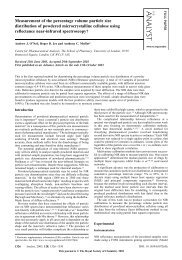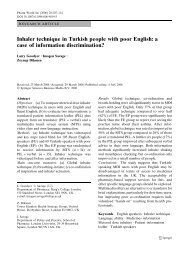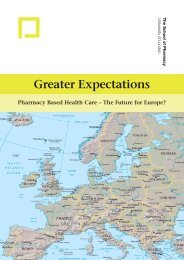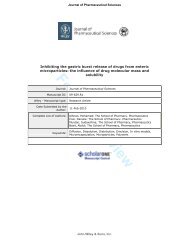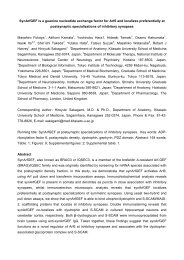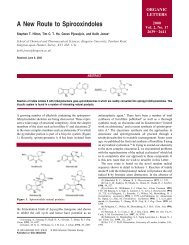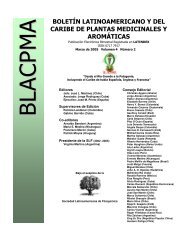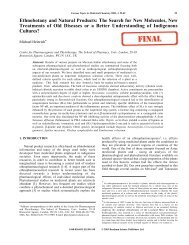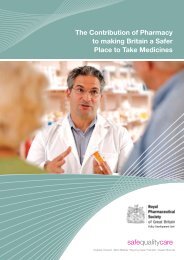(ADR) Reporting by Pharmacists - Pharmacy Eprints
(ADR) Reporting by Pharmacists - Pharmacy Eprints
(ADR) Reporting by Pharmacists - Pharmacy Eprints
You also want an ePaper? Increase the reach of your titles
YUMPU automatically turns print PDFs into web optimized ePapers that Google loves.
<strong>Pharmacists</strong>- the scientists in the high street<br />
Adverse drug reaction (<strong>ADR</strong>) reporting <strong>by</strong> pharmacists<br />
Useful information for pharmacists<br />
Introduction<br />
The yellow card scheme for reporting suspected adverse drug reactions (<strong>ADR</strong>s) was<br />
introduced in 1964 and over 400,000 reports have now been received <strong>by</strong> the<br />
Committee on Safety of Medicines (CSM) / Medicines and Healthcare products<br />
Regulatory Agency (MHRA).<br />
The monitoring of new medicines is a vital part of the licensing process. A new drug<br />
will only have been clinically tested in a few thousand patients, although millions may<br />
take it when it is marketed. The reporting of <strong>ADR</strong>s can identify those drugs for which<br />
special precautions may be necessary because of the identification of uncommon<br />
adverse effects. If the severity and incidence of adverse effects outweigh the benefits<br />
of a drug it may even be necessary to withdraw marketing authorisation.<br />
Key points for pharmacists<br />
• Those who can report are doctors, dentists, coroners, pharmacists, nurses,<br />
midwives, health visitors, and pharmaceutical companies under statutory<br />
obligations.<br />
• The Society's Code of Ethics states "pharmacists must be alert to potential<br />
adverse drug reactions and drug interactions and respond accordingly".<br />
• All suspected <strong>ADR</strong>s for black triangle drugs and vaccines, all serious suspected<br />
reactions for established drugs and vaccines, and suspected <strong>ADR</strong>s associated<br />
with licensed and unlicensed herbal medicines should be reported.<br />
• <strong>Pharmacists</strong> do not have to be certain that a medicine has caused the reaction. A<br />
suspicion is enough to report - if in doubt, fill a card out.<br />
• Special attention should be given to vulnerable groups - patients who are<br />
pregnant, nursing mothers, elderly, or who have a history of allergies. All<br />
suspected adverse drug reactions in children should be reported.<br />
Role of pharmacists<br />
Community pharmacists are well placed to report <strong>ADR</strong>s associated with OTC<br />
medicines and herbal products. Further expected deregulation of medicines and<br />
increased clinical and prescribing roles for pharmacists will enhance these<br />
opportunities, increase the level of reporting and yield high-quality information not<br />
previously available. 1 Although most pharmacists are aware of the scheme, some<br />
may be unclear about what should be reported. 2<br />
Hospital pharmacists have been using the yellow card scheme since 1997 and in<br />
1999 all community pharmacists were included. The table gives the number of<br />
reports received from hospital and community pharmacists from 1997, with the total<br />
number of reports received for comparison. <strong>Pharmacists</strong> now report about 16% of the<br />
total.<br />
Description of <strong>ADR</strong>s<br />
An <strong>ADR</strong> is defined <strong>by</strong> the MHRA as "an unwanted or harmful reaction experienced<br />
following the administration of a drug or combination of drugs under normal<br />
conditions of use and which is suspected to be related to the drug". 3<br />
1
<strong>ADR</strong>s may be an extension of the normal pharmacological effect of the drug, such as<br />
severe low blood pressure with an antihypertensive agent. Effects are usually doserelated.<br />
The second type of <strong>ADR</strong>s are idiosyncratic, not expected from the usual use<br />
of the drug, such as anaphylactic shock from penicillin administration.<br />
When to report<br />
All suspected <strong>ADR</strong>s for new medicines for which the safety profile has not yet been<br />
completely established should be reported. These are known as black triangle drugs<br />
and vaccines, and are identified <strong>by</strong> the symbol "▼" on the product and in medicines<br />
information sources.<br />
All serious suspected <strong>ADR</strong>s for established medicines and vaccines should be<br />
reported. The MHRA lists serious reactions as those that are fatal, life-threatening,<br />
disabling or incapacitating, result in or prolong hospitalisation, and/or are medically<br />
significant. Some examples are given in the MHRA's Guidance Notes for reporting<br />
suspected <strong>ADR</strong>s. 3<br />
It is only necessary for the reporter to reasonably suspect that the medicine has<br />
caused the <strong>ADR</strong>. Factors to be considered are the nature of the reaction, timing,<br />
relation to dose, and other possible causes. Reports should be made even if the<br />
reaction is already recognised (e.g. gastrointestinal bleeding with NSAIDs). The<br />
MHRA advice is “If in doubt, fill a card out”.<br />
As well as reporting all suspected <strong>ADR</strong>s for black triangle drugs and serious <strong>ADR</strong>s<br />
for prescribed and OTC medicines, reports should be made for all suspected <strong>ADR</strong>s<br />
for herbal medicines (licensed and unlicensed), and <strong>ADR</strong>s in children and the elderly.<br />
Herbal medicines<br />
The MHRA wishes to receive reports of suspected <strong>ADR</strong>s associated with all herbal<br />
medicines, so that their safety can be monitored. Many unlicensed herbal remedies<br />
are purchased from outlets other than pharmacies, including Ayurvedic and<br />
Traditional Chinese Medicines. The information the MHRA requires about the product<br />
is the ingredient(s), source or supplier, and the use to which the remedy was being<br />
put. Retention of a sample of the product would be helpful in case an analysis is<br />
required.<br />
Although the first yellow card for Kava-kava products was not received in the UK until<br />
February 2002, it reinforced information about the herb's toxicity gathered from<br />
German and Swiss sources. Kava-kava products were eventually banned because<br />
the risks outweighed the benefits. Herbal products containing Aristolochia have also<br />
been banned, and the dangers of drug interactions with St John’s wort 4 have<br />
recently been brought to light <strong>by</strong> the CSM. This emphasises that herbal products may<br />
not always be safe and that the monitoring of their <strong>ADR</strong>s and drug interactions is<br />
vital.<br />
Children's medicines<br />
Children are not just small adults and may have very different reactions to medicines.<br />
Also, many medicines are not licensed for use in children and they have not been<br />
subjected to clinical trials in those who are under 18 years. Their safety profile in<br />
children will not be known and the MHRA would like all suspected <strong>ADR</strong>s in children<br />
to be reported.<br />
2
The elderly<br />
The elderly are at particular risk of <strong>ADR</strong>s and interactions, particularly during longterm<br />
therapy, because of polypharmacy, co-existing chronic disease and a reduced<br />
capacity to eliminate drugs. Any suspected <strong>ADR</strong>s in the elderly should be reported.<br />
<strong>Reporting</strong><br />
Yellow cards may be found in the BNF 5 , MIMS, the ABPI’s Compendium of Data<br />
Sheets and Summaries of Product Characteristics, and PAGB’s OTC Directory. A<br />
paper copy can be downloaded from the MHRA Internet website or the form can be<br />
completed and submitted electronically [www.mhra.gov.uk].<br />
The four critical pieces of information that must be included on the yellow card are:<br />
1. Suspected drug(s) – brand name of medicine(s) (or name and manufacturer for<br />
herbal medicines) and batch number if known, route of administration, dosage,<br />
dates of administration and indication.<br />
2. Suspected reaction(s) – a description of the reaction(s) and any treatment given,<br />
together with the dates the reaction started and stopped, and whether the<br />
reaction was considered to be serious. There are also tick boxes to give<br />
information on the outcome, and why the reaction was considered to be serious.<br />
3. Patient details – the essential details are patient’s sex and age, and their weight<br />
(if known). Information that would identify the patient should not be used (for<br />
reasons of confidentiality) although their initials and a local identification number<br />
are helpful in case it is necessary to refer back to the patient. It is not necessary<br />
to obtain the patient’s consent to report an <strong>ADR</strong>, although this should be<br />
discussed with the patient.<br />
4. Reporter details – the name and full professional address of the reporter, so that<br />
the report can be acknowledged and contact made for further information, if<br />
necessary.<br />
Additional information supplied may include other medicines taken, and diagnostic<br />
test results and known allergies.<br />
MHRA action<br />
When the MHRA receives the yellow cards, the information is entered on to the<br />
Adverse Drug Reaction On-line Information Tracking (<strong>ADR</strong>OIT) system. This data<br />
base, and other published information on <strong>ADR</strong>s, is evaluated weekly to identify<br />
potential new hazards and generate further information on known adverse effects of<br />
drugs. Information about the risks, and potential risks, can then be balanced against<br />
the proven benefits of the medicine.<br />
Action that may be taken includes informing healthcare professionals of the new<br />
risks, reducing the recommended dose of the medicine, or withdrawing a medicine<br />
from the market.<br />
All yellow card reports are acknowledged, quoting an <strong>ADR</strong>OIT registration number. If<br />
requested, the MHRA will supply information about other reports associated with the<br />
drug.<br />
References<br />
1. Major E. The yellow card scheme and the role of pharmacists as reporters. Pharm. J. 2002;<br />
269: 25-6<br />
2. Cox A. Embracing <strong>ADR</strong> reporting could improve pharmacists’ standing. Pharm. J. 2002;<br />
269: 14<br />
3
3. Committee on Safety of Medicines, and Medicines and Healthcare products Regulatory<br />
Agency. Suspected adverse drug reaction (<strong>ADR</strong>) reporting and the yellow card scheme<br />
guidance notes. MHRA web site:<br />
http://medicines.mhra.gov.uk/ourwork/monitorssafequalmed/yellowcard/yellowcardscheme.ht<br />
m<br />
4. Information sheet: "Herb-medicine interactions: St John’s wort (Hypericum perforatum)".<br />
Royal Pharmaceutical Society, September 2002<br />
5. Anon. Adverse reactions to drugs. British National Formulary 46. London: British Medical<br />
Association and Royal Pharmaceutical Society of Great Britain, September 2003, p 10.<br />
Further reading<br />
Lee A, editor. Adverse drug reactions. London: Pharmaceutical Press, 2001<br />
This information sheet was commissioned <strong>by</strong> the Science Committee of the Royal<br />
Pharmaceutical Society of Great Britain. The author is Professor Tony Moffat DSc,<br />
FRPharmS, Chief Scientist of the Society, with assistance from the MHRA and<br />
members of the Science Committee.<br />
This information sheet can be found on the Society’s website at: www.rpsgb.org.uk<br />
Copyright Royal Pharmaceutical Society, September 2003<br />
Number of <strong>ADR</strong> reports submitted <strong>by</strong> hospital and community pharmacists since<br />
1997 in relation to all UK reports. [From reference 1]<br />
Year Hospital Community All other<br />
1997 713 125 15,798<br />
1998 1,104 168 16,791<br />
1999 1,336 142 17,024<br />
2000 1,842 508 *30,770<br />
2001 1,858 599 18,899<br />
2002 2,094 556 13,629<br />
Total 8,947 2,098 112,911<br />
* Increased due to a national campaign for vaccination against Meningitis C<br />
4



